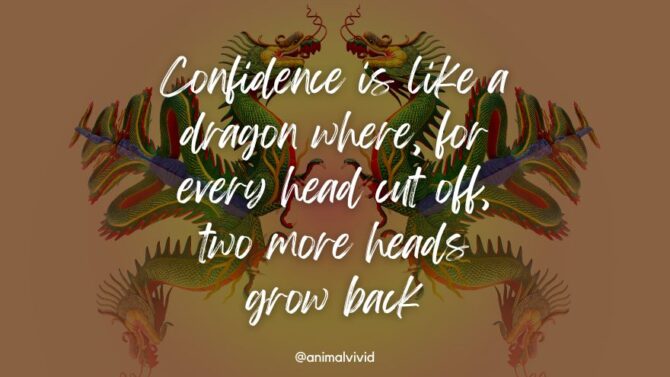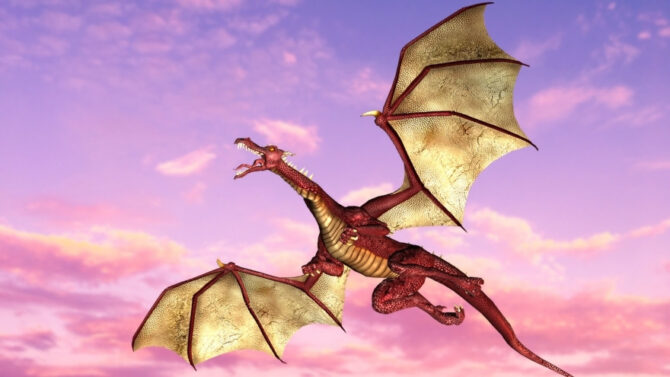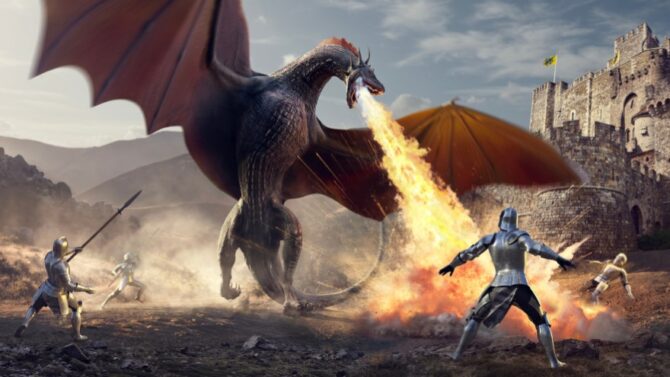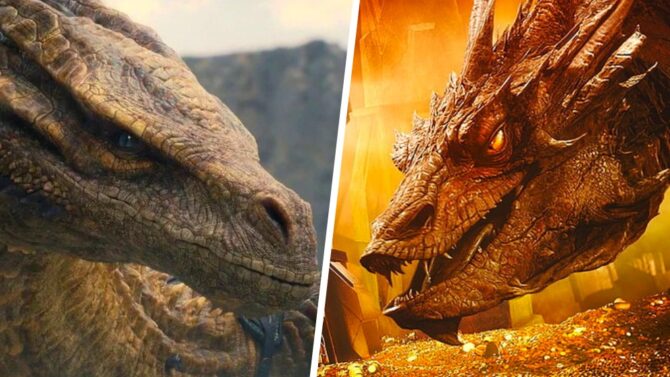Many cultures have their concept of dragons that reflect a lot of their core values.
That said, few cultures revere dragons like the Chinese do. You can’t detach this creature from their legends, folklore, and their general culture.
On the Chinese New Year, many displays involve dragons.1 You can’t underestimate the importance of these creatures to the Chinese.
Unlike western culture, Chinese dragons are portrayed in a positive light.
They are often wise characters and symbolize fortune, power, and strength, among others.
It was associated with the Emperor of China throughout history and had even been worshiped.
History of Chinese Dragons
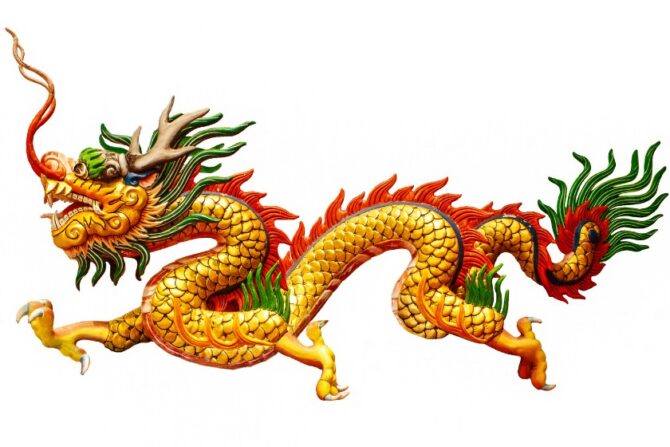
The initial origin of Chinese dragons is unclear, but they’ve been around for a very long time.
The prevalent explanation is that the dragon came about through totems used by tribes.2
According to legend, the yellow emperor Huangdi waged war on all other tribes and defeated them.
After uniting the country, he incorporated their totem into his own, creating the Chinese dragon as a national image.
He became the emblem, and the Chinese people became the descendants of dragons.
The aforementioned origin is stated in The Records of the Grand Historian, but it isn’t the only explanation available.
Another was proffered in The Chinese Etymology Dictionary, which saw the dragon as an element of a myth responsible for creating rain. The third explanation has a link to dinosaurs.
It’s possible that the ancient Chinese considered dragons as real, especially after discovering dinosaur fossils.
Reports showed that villagers in central China still used dinosaur bones as “dragon bones.”3
Dive Deeper: Dinosaurs vs. Dragons: What’s The Difference?
This type of dragon looks like a combination of different animals, which gives credence to the first origin that covers Huangdi.
It has the head of cattle, deer antlers, the ear of an elephant, and many other depictions.
Significance of Chinese Dragons
Chinese dragons mean more than fictional characters in myths and legends.
As already noted, they have a high value. Here are some ways they are significant:
The Chinese horoscope
The Chinese horoscope has 12 zodiac animals, including the dragon. Others include the rat, ox, rabbit, tiger, and dog.
The dragon is the fifth animal in the zodiac. Every Chinese year is termed by a zodiac animal.
The next year of the dragon is from February 10th, 2024, to January 28, 2025.
Good luck
Another symbol of the dragon is that of fortune, prosperity, and good harvest.
This reputation stems from Ancient China’s legend centered around Shennong, the “Divine Farmer.”4
Shennong was the son of a dragon and a princess. At birth, he was described as having a bull head with the body of a human.
He’s linked with agriculture and herbal medicine, making him a hero. Because he’s said to come from dragons, the latter got this positive image.
Power
Dragons symbolized power, especially due to their association with emperors.
This must have begun after Huangdi united China and continued through the dynasties.
Emperor Liu Bang of the Han dynasty attached his power to an alleged dream his mother had before she conceived him.
Other emperors wore robes with dragons on them and made objects out of authority out of dragons.
Weather and water
The Chinese believed dragons could control nature and were considered kings of weather and water. This includes waterfalls, rainfall, seas, and rivers.
Even more, dragons are termed kings of the four seas in the North, East, West, and South. In some villages, dragons are still worshiped.5
China
Overall, the dragon is a symbol of China and Chinese culture.
Even those living overseas hold on to the dragon as a sign of their identity.
This creature is prevalent in their literature, festivals, and other cultural depictions.
Types of Chinese Dragons
Chinese dragons can be classified into 8 different types, each with distinct attributes. They are:
1. Azure dragon
The azure dragon also goes by the name green dragon. It plays an important role in Chinese mythology, being one of the four mythological creatures.6
Each of these creatures represented a particular direction. The azure dragon was for the east.
This creature could also control rain and wind.
2. Winged dragon
As the name implies, the winged dragon stayed in the sky.
It is an important dragon type and–according to some legends–is said to be the ancestor of dragons.
It also has affiliations with the Yellow Emperor. The winged dragon is also known as Ying Long. It controls the four seasons.7
3. Coiling dragon
Unlike the winged dragon, coiling dragons don’t fly. They look like giant snakes bereft of wings and stay in the water.
It is also known as Panlong. The coiling dragon was said to be a controller of time.
4. Horned dragon
This is not to be confused with the mountain horned dragon, which is not a mythological creature.
This Chinese creature lived more than 500 years ago. It departs from the positive reputation of Chinese dragons by being a villain capable of creating a flood.
5. Underworld dragon
Not surprisingly, the underworld dragon stays underground. It could also be found in seas, rivers, and lakes.
It can control the waters in its habitat.
6. Treasure dragon
The treasure dragon is also called Fuzanglong, and as the name shows, it is the Chinese dragon of hidden treasures.
Much like the western conception of dragons that we see in classics like The Hobbit, this dragon protects buried treasure.
They’re credited with forming volcanoes.
7. Cloud dragon
The cloud dragon also goes by the proper name Feilong, a word that translates as “flying dragon.”
This dragon type is quite popular, especially among painters. Feilong lives in the cloud and is a rainmaker.
8. Dragon king
The dragon king is highly revered amongst the Chinese. It is considered the most powerful and intelligent in China.
The dragon king can channel the seas and take human form.
Nine Sons of The Dragon
According to Chinese myth, the dragon king had nine sons, recorded in different accounts. Though there are variations in these accounts, they all agree on the number of sons. Here they are:
- Bixi is the eldest of all sons. He has a turtle shell.
- Qiuniu is known for his musical abilities and passion for the field. It is described as yellow and covered in scales.
- Yazi is a bloodthirsty fighter with a snake belly and the head of a leopard.
- Pulao is an odd dragon, as he cries a lot more than you’d expect from this type of creature.
- Bi’an is into lawsuits and loves to stay around prisons, the best place to find these lawsuits.
- Chiwen has a dangerous edge, devouring different creatures. His voice alone makes him seem very dangerous.
- Suanni is known for its sitting posture. He stays cross-legged like a Buddhist monk. Not surprisingly, you’d find it in Buddhist temples.
- Fuxi is a hero in Chinese myth because of what he had done. Together with his sister and wife, he created humans and invented music.
- Chaofeng has a knack for adventures.
Other Interesting Chinese Dragon Facts
Chinese dragons come in different colors, each with their meaning. For example, blue and green signify new life and plant growth.
The red stands for luck and good fortune, while the black is evil and revenge. These colors and more are important for symbolic purposes.
Another notable fact is that emperors were associated with dragons so much that they were called sons of dragons.
Only emperors had images of these creatures; the common man couldn’t.
In the aforementioned sections, we pointed out that the ancient Chinese possibly believed dragons existed because of dinosaur fossils.
However, there is no evidence of their existence. They remain in the world of legends, myths, and cultural symbols.
The final fact concerns their physical traits. They look like long snakes, and some have wings. This differs from the bigger western dragons.
Related: 40 Dragon Facts & Legends You Probably Didn’t Know
Final Thoughts
Chinese dragons are spectacular. Mostly positive (with some exceptions), these creatures are known to symbolize fortune, prosperity, power, and other good things that show how endearing they are to the Chinese.
We look forward to the year of the dragon!
References & Notes
- Dragon Dance. Smithsonian’s National Museum of Asian Art.
- Dragon and Phoenix Totems in Chinese Traditional Architecture. ChinaCulture.
- Dinosaur bones ‘used as medicine.’ BBC News.
- Shennong, Chinese mythological emperor. Britannica.
- Communal Worship and Festivals in Chinese Villages. Oxford Academic.
- Four Mythological Creatures in China. CITS.
- Ying Long 应龙 (yīng lóng). China Beasts and Legends.

